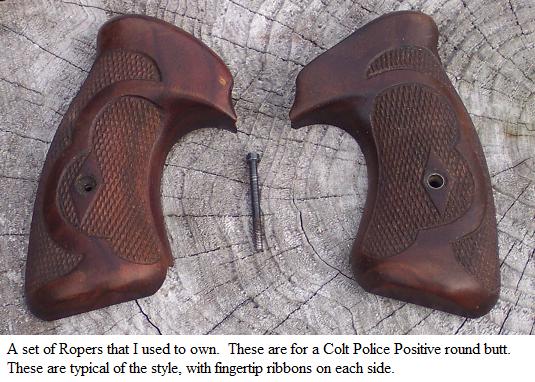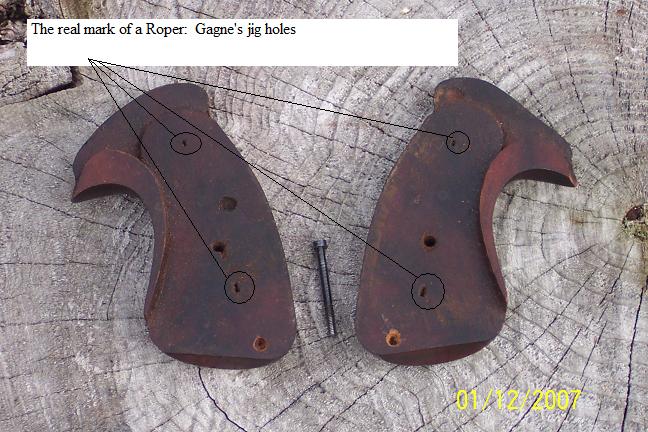I have a great interest in vintage Roper grips
(as well as Lew Sanderson grips, which I’ll no doubt write
about soon). I own a couple pairs, have traded off a couple,
and am always looking for more. Roper grips are a niche in the
shooting collectibles and antiques market, and there’s not a
lot of published documentation about them. It’s a hard subject
to Google, with most of the good information passed word of
mouth between knowledgeable collectors. Here’s my
contribution. Much of what I’ve learned has been taken from
taken from internet forum boards, personal examination of
Roper stocks and pictures of them, and one great article by
Kevin Williams in Man at Arms magazine.
Roper grips were aftermarket target stocks
marketed by Walter Roper from about 1934 to 1952. They were
handmade, from wood, and production numbers reflect a relative
scarcity compared to the abundance of something that was
machine or assembly line produced (think about how you can
always find older Franzite grips).
Roper’s grips were made by two stock makers in
his employ - Matheis Gagne and WDH Nichols. Gagne made grips
during the entire run, with Nichols joining during the mid to
late period to focus on grip panels for semi-automatic
pistols. Gagne’s specialty was revolver stocks, and the
distinctive three arched finger tip ribbon found on many Roper
grips was his signature mark. The ribbon, in combination with
a couple other more subtle features, is the way most Roper
stock’s are identified and authenticated.
Roper grips that survive to this day command
high prices. The highest I’ve seen was around $950 for a set
of N frame stocks on EBay about two years ago (when money was
flush…). I believe under normal circumstances, $500 give or
take is a more typical amount for a set of Roper’s in good
condition – though that’s still a real good price for a set of
grips.
Having mentioned the rarity and the current
prices, it’s my suspicion there’s a fair amount of Roper
stocks out there (residing on vintage handguns) that are not
immediately identifiable as Roper’s at first glance. Most
conspicuously, these tend to lack the Roper (i.e., Gagne)
fingertip ribbon.
Roper stocks do not have a maker’s mark, so in
any event the task of authenticating a set of Roper stocks is
entirely a matter of confidence. In effect, the degree to
which the stocks conform to the commonly understood Roper
pattern determines what they’re worth. The ribbon is a usually
a dead giveaway. When it’s present, those grips command the
highest prices. In many cases, grips without the ribbon are
selling for no premium at all because the buyer and seller
aren’t aware the grips are Roper’s.

Here’s a list of other features and
assumptions that might help determine if a set of antique
grips conform to the Roper style and are in fact
Roper’s:
1. Almost without exception, Roper grips will
show two small, squarish stake holes (one low, one high, an
inch and a half or so apart) on the backs of each panel. These
jig holes were created when Gagne and Nichols mounted the
panels onto their checkering saddle so they could cut the
checkering. Possible exception: some grips with an otherwise
typical Roper ribbon or scallop will have round, machine cut
jig holes in back. There’s some speculation these are not
Roper grips, but those of an imitator from the same time or
more recent. However, there’s also the counter speculation
that these are in fact Roper grips, made during the late
period when a more inexpensive machine checkering option was
offered by Roper.

2. The Roper ribbon as
commonly known may appear on both panels, one, or none at all.
Two ribboned panels or a set with none at all signifies an
ambidextrous set. Sets with one ribbon usually show this on
the left panel (border outlines the fingertips of the strong
hand, most people are right-handed). Conversely, left-handed
Roper grips with one ribbon on the right panel are a REAL
rarity. If you encounter set of vintage, checkered, but
unribboned grips that otherwise bear a strong resemblance to
Ropers, examine the backs of the panels for jig holes. The
presence of the jig marks in combination with other Roper
features goes a long way in authentication.
3. The most common, unribboned sets are
ambidextrous revolver grips that are shaped a lot like Colt
Python stocks. When encountered, these are almost fully
checkered. Look for the jig holes. But, Griffin & Howe
stocks from the same period look a quite a bit like these.
These are pretty desirable themselves though.
4. There are quite a few variations of the
fingertip border or scallop to be found. A fully checkered
panel - with the three arched, two pointed, uncheckered ribbon
- is obviously the most common. Other variations include three
finger tip impressions on one panel, with these indentations
being checkered. Or, checkering on the fingertip side may
appear on the inner half, ending with a leaf edge pattern in
the center of the grip (again, 2 pointed). The backstrap side
is uncheckered. If you see a set of vintage grips with ornate
fingertip checkering on one side, again, look for jig marks on
the backs of the panels to further confirm as
Ropers.
5. Almost without exception you should assume
all Roper grips will have at least one diamond showing around
a grip screw hole (on either panel). The other panel may have
its hole in an uncheckered area, but if it is in a checkered
area, it should have a diamond around it. The tallness of the
diamonds on the vertical axis may vary any given set. This is
a matter of the degree to which the checkering lines
intersect. I observe some set to set variation, it does not
appear Gagne had a standard pattern.
6. All genuine Roper grips should have
checkering of some sort. Hand checkering on Roper grips has
been described as “organic” (Williams words in Man at Arms - I
thinks it’s a good description). It’s well executed, at about
18 lines per inch. Nonetheless, real Ropers may show some very
light scribe overruns into the borders. This is common,
typical, and good for authentication.
7. Grips screw sets will generally be of the
type Smith and Wesson used during the same era. Brass
escutcheons, unblued screw.
8. Sets for the Colt medium frame
double-action revolvers of the day are the most numerous, with
similar Smiths a close second. But Ropers were also made for
the Colt Single Action Army, Police Positive, 1911, Woodsman,
H&R USRA, and the various High Standard semi-auto 22s (B,
HD).
9. Roper revolver grips usually display a
‘coke bottle’ shape, with a slight flair at the bottom and a
swell in the palm side. Roper grips heavily influenced Smith’s
later ‘coke bottle’ N frame grips (see Williams). Roper grips
usually add a fair amount of length to the butt. Roper grips,
even when covering the entire frame, are somewhat
slim.
10. Thumbrests are often encountered on Roper
grips, and almost always show checkering into the
thumbpad.
11. Wood and finish color on Ropers will vary.
They’re mostly walnut, with stains ranging from dark
purplish/red to light honey.
I think quite a few collectors are conditioned
to dismiss and walk by vintage handguns (slightly pre and post
war anyway) that don’t have their original stocks. I look at
these guns closely. Ignoring the Jay Scott and Franzite stuff
is no doubt very easy, but a nice set of vintage aftermarket
stocks really intrigues me. These are the criteria I use to
determine if they’re Roper’s, and I think, a reasonable
authentication guide.
I’ve tried to attribute info to published
authors who deserve credit. The rest is my own observations.
Enjoy – buy wisely and sell honestly with appropriate
caveats.